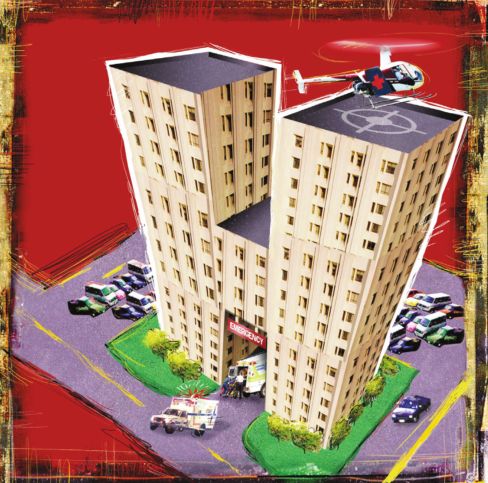Charity cases
Shouldn’t profit-seeking nonprofits pay property taxes?
DYSPEPSIANA | James Krohe Jr.
The debate that Illinois ought to be having about government finance is not how much property owners should pay in taxes, but which property owners should pay. Large quasi-corporate nonprofit corporations such as private hospitals and universities behave like their profit-making cousins, and are among the biggest land-owners in many a town, yet such organizations enjoy the same exemption from taxation by state and federal law as churches or bread lines or adoption agencies. (Government agencies are exempt too, which is a particular problem for Springfield, but that is a subject for a later column.)
The policy dates from the era when providing charitable care was what most hospitals were for, there not yet being a system of private insurance or public social services. The assumption baked into the tax exemption for, say, nonprofit hospitals is that what we give them in lower taxes they will give away in care to people who can’t pay for it themselves. That’s dubious on its face even when hospitals do give it away, since it masks public welfare spending by making it a tax expenditure rather than a budgeted expenditure. The larger problem is that hospitals don’t always give it away.
A few years ago the Illinois Department of Revenue ruled that the Catholic-owned Provena Covenant Medical Center in Urbana should lose its property tax exemption because the value of care provided to indigent patients amounted to less than 1 percent of its revenue in 2002. As a result, Provena now pays property taxes like any other hospital – more than $1 million a year to help pay for Urbana government. IDoR made a similar ruling in 2011 against three hospitals, including Decatur Memorial Hospital. The institutions provided free and discounted medical care that ranged from 0.96 percent to 1.85 percent of patient-care revenue.
They probably spend nearly that much to have the plants in the lobby watered. In fiscal year 2013, Memorial Health System, the corporate parent of Springfield’s Memorial Medical Center, spent about 3 percent of the system’s net patient service revenues of $646 million for that period – enough for the tax police, apparently, but hardly so much as to shame a St. Francis.
IDoR in 2011 reportedly suspected another 15 hospitals of not earning their keep. No ambulance ever got to a heart attack victim faster than hospital industry lobbyists got to Springfield to get the tax exemption rules changed. (Hospitals are generous donors to legislators, who received $440,000 from the Illinois Hospital Association in 2013.) The result in 2012 was new and broader tests of worthiness for tax exemption. Under the new rules, hospitals must prove – well, assert via accounting, which is hardly the same thing – that they spend on approved good works as much or more than they save by not paying property taxes.
That sounds like a good deal.
It was drafted to sound like a good deal. Under the new definitions, MMS reported that it spent a bit more than 11 percent of patient revenues on “community benefits.” (Using different but also generous definitions, nonprofit hospitals nationally spent an average of 7.5 percent of their operating costs on such things.) But the benefit to the public of many of the qualifying costs under the new rules is nebulous, and accounting for them is arbitrary. And since any minimum requirement tends to become the new standard, I see no reason not to expect that hospitals spending more on qualifying services than the minimum required to earn their exemption will cut back that spending.
The fact some nonprofits provide less free care than other nonprofits matters less than that nonprofits as a class don’t provide much more care than do forprofits. In a 2006 paper, Congressional Budget Office analysts noted that because for-profit hospitals do not receive tax exemptions and are not required to meet community-benefit standards, the level of community benefits they provide is a useful benchmark against which to compare nonprofit hospitals. The CBO found that, on average, nonprofit hospitals provided higher levels of uncompensated care than did otherwise similar for-profit hospitals, but that many for-profits gave more than nonprofits in the same towns.
Two points stood out. One, when the spending numbers are adjusted to account for differences of hospitals’ size, location and patient base, spending by nonprofits was less than one percent higher than that of similar for-profit hospitals. And two, a couple of studies found that when nonprofit hospitals were acquired by for-profit corporations, they did not reduce their provision of uncompensated care or other community benefits.
If for-profits provide about as much or more care than even the more generous nonprofits, and do so while paying property taxes to local governments, what’s the point of the exemption for nonprofits? The answer is obvious. I will ask another question: Lives there a lawmaker with heart so brave that she will dare the medical industry’s wrath by seeking to restore local government’s tax base, simplify the tax system and restore something like common sense to public policy?
Contact James Krohe Jr. at [email protected].
Editor’s note
Many
of us are hoping that Bruce Rauner won’t be as bad as we think he’s
going to be. Even some of his supporters are secretly pleased that Mike
Madigan is still in control to shield the state from Rauner’s more
radical ideas. It is up to the governor-elect to set the tone. Will he
continue to be shrill and divisive? Or will he tone it down, support the
schools, replace lost revenues and propose genuine reform? Illinois
will survive, but there are tough days ahead. –Fletcher Farrar, editor
and publisher